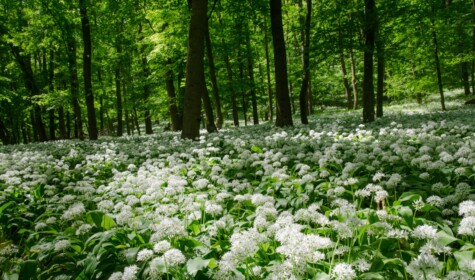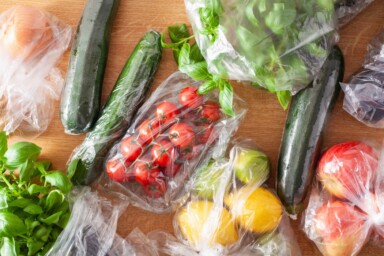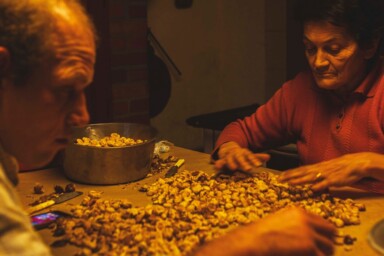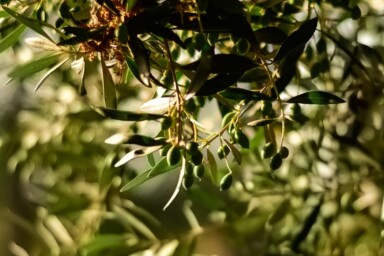As April draws on, we get our first glimpse of sunshine and warmer days. But just as we shed our multiple layers and start sparking up the barbecue, the grey clouds roll in and hailstones pelt down on our misguided enthusiasm.
Our expectations of what produce is in season in spring are similarly unrealistic. Our eagerness to shrug off the monotony of winter is evident in how prematurely spring foods appear on restaurant menus and in glossy supermarket magazines, enticing us with peas, broad beans, asparagus and new potatoes. The supermarket shelves overflow with fresh spring produce, but if you look a bit closer at the label, the majority will be imported from far off places – Thailand, Mexico, Tanzania, Israel. The reality for British farmers is that April is the leanest month of the year.
Spring in Britain is not what you might expect – there is no new overflowing bounty. Rather, this is the period when the winter crops of cabbage and kale have bolted and the stores of potatoes, onions and roots are running out. Spring vegetables have only just been sown and won’t be ready to harvest until May and June. We call this the ‘hungry gap’ and it comprises the better part of spring. Most of us are blissfully unaware of it because the supermarkets do such a great job of supplying us with cheap and abundant fresh produce all year round. So much so, that seasons hardly seem to matter.
Before imported produce was affordable for the masses, eating in the hungry gap was both hard and uninspiring – a diet dominated by old potatoes and cabbage. Preserved fruits and vegetables from other seasons provided some variety in our food during this period. But, more recently, the introduction of protected cropping on a commercial scale has greatly expanded the range of vegetables available to eat in Britain during the spring.
The argument around sustainable food has shifted from food miles to resource efficiency. Factors such as the kind of food we eat, where and how it’s grown can have a bigger impact on greenhouse gas (GHG) emissions than how far it’s travelled. The food sector accounts for 30% of global energy consumption and produces about 20% of GHG emissions (see the 2011 FAO report). The majority of this energy consumption comes from oil and gas in the form of artificial fertilizers and pesticides, on-farm machinery and food processing. Vegetable consumption in Britain has shifted from brassicas and roots to Mediterranean ‘ratatouille’ vegetables and salads. These demand more energy usage, either from importing or from using heated greenhouses in colder climates. They often require refrigeration in transit, which is another huge energy drain.
At Crop Drop, the London veg box scheme I run, we believe a sustainable diet is made up of mostly plant-based, minimally processed, seasonal food. We’re grateful to our Spanish farmers who supply us with seasonal veg during the hungry gap. They help us keep our weekly offering interesting and varied, complementing what’s available in Britain. We only import produce that can be shipped from nearby European countries. Sourcing from further afield would move us into the realm of refrigerated, air-freighted transportation, which has a much greater carbon footprint.
So what’s actually in season in spring and when is British-grown produce available?
Purple sprouting broccoli (January – April)
This English variety of broccoli provides much-needed pizzazz to the early spring kitchen. The mild winter this year has brought it on early, so grab it now while you still can.
Wild garlic (February – April)
Found in abundance in woodlands and damp shaded banks, its leaves smell richly of garlic and can be chopped and added to stews, salads, pasta or soups. The white flowers, like clusters of stars, make a striking addition to salads.
Rhubarb (January – July)
This wonderful native British vegetable is our closest possible thing to fruit in spring. Forced rhubarb is available as early as January. Cultivated in the dark in unlit sheds, it hunts for the light, growing three times quicker. It’s a shocking pink and is softer and sweeter than the conventionally grown rhubarb.
Spring greens (March – June)
The first of the new season cabbages – their dark green leaves are softer and tenderer than the hardy red and winter cabbages. Try them simply sautéed with oil and caraway seeds.
Asparagus (late April – June)
This has a very short season in Britain and usually arrives in May but could appear earlier due to last year’s hot summer. The global demand for asparagus is met by Peruvian and Mexican exports. On top of the air miles this luxury veg clocks up, it’s also depleting the water table in these water-stressed regions. It’s worth waiting a little longer and paying a bit extra for the native stuff.
New potatoes (March – July)
Until the British season really kicks in, many of the new potatoes in the supermarkets will be from Israel. Jersey Royals and Cornish ‘earlies’ are the finest flavoured new potatoes, with a soft skin that will rub off with your fingers. They’re usually sold with a bit of soil on them – this helps keep them fresher for longer.
Cauliflowers (almost year round)
Different varieties of cauliflower planted throughout the year provide a year-round supply. Winter cauliflower is available from November to May and then in June the summer varieties come in. Roasting it with chilli or cinnamon transforms this lesser-loved brassica into an exotic treat.
Radishes (April – September)
Radishes pop up quickly, taking just four weeks from seed. They will grow pretty much anywhere. Beautifully crunchy and sharp, they’re great raw in salads and are a staple component of Japanese and Chinese cooking.
Lettuce and leaves (March – December)
Salad leaves are in abundance right now. Polytunnels enable us to grow lettuces and leaves (such as rocket, land cress, mizuna, pak choi) in colder climates by trapping heat and humidity and warming up the soil naturally. Calabaza Growers, a market garden farm in South London, supply us with a great range of lettuce, leaves and oriental greens grown in their polytunnels throughout the hungry gap.
Where to shop
Greengrocers
Fast vanishing from the British high street, greengrocers need your support. A good greengrocer can tell you where it sources its produce, what’s in season and how it chooses what to stock. As a small business it will respond well to your requests for seasonal produce.
Box schemes
Box schemes provide you with a weekly selection of seasonal produce and mostly come from small-scale producers or urban sustainable food projects that may source from multiple suppliers. Not all schemes are organic, so check on this and know what you’re getting. It’s a great way to learn about new vegetables, and it takes the effort out of deciding what to buy. In the hungry gap, it’s hard to provide a box that’s wholly British produce, so some vegetables may be bought-in by the producer. Find out where this is coming from, how it’s travelling and how far – freshness is one of best things about a local box scheme, so don’t compromise on this.
Farmers’ markets
For the majority of us, this is our only opportunity to meet a farmer face-to-face. It’s hugely valuable to be able to talk directly to the person producing your food and gain a better understanding of what’s growing when, how the weather is affecting harvests and the broader realities of farming.
Eating locally and seasonally isn’t just the ethical choice – what’s good for the planet is also good for your health. It means having a much more varied diet throughout the year and eating food that is (largely) fresh off the field. Local seasonal produce is grown for its taste, rather than its ability to withstand long journeys, and it’s picked when it’s ripe, making for nutritious meals packed with great flavour.
I also find that having a smaller assortment of things to eat makes me more creative in the kitchen and I feel more connected to the natural cycles of life – more in tune with the weather, the earth and the people that produce my food. This in turn makes me more grateful for the food that I eat.
We face many challenges in feeding our growing population fairly and sustainably, and it’s critical we make changes now. We need to be more resource efficient in how we produce and transport food, and waste much less of it. As consumers, we have to fall in love with vegetables and eat more of our native produce again. With easy access to spices and culinary influences from around the world, there’s no excuse not to make any food interesting and delicious. The payoffs are great: tastier food, better health and a greater appreciation of the wonderful bounty of our produce.







